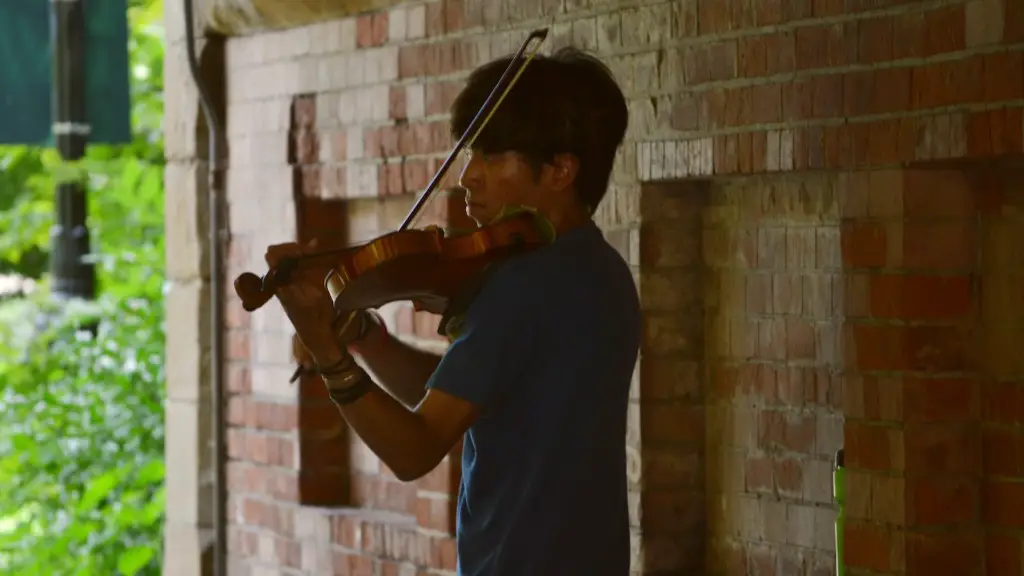The violin is a beautiful and intricate instrument, renowned for its sweet and powerful sound. It is capable of producing an incredible range of sounds, from delicate melodies to thunderous crescendos.
The sound of the violin is produced by vibrating strings stretched across the instrument’s body. When a musician bows the strings, they vibrate and create sound waves which travel through the air and are heard by an audience. The strings are able to produce different notes depending on their length and tension, as well as how hard the musician is bowing or plucking them. Additionally, changes in pitch can also be achieved by pressing down one or more of the four strings with the left hand.
The quality of the sound produced also depends on how the wood of which the violin is made resonates. The body of the instrument acts like an amplifier for the sound waves produced by vibrating strings. As such, a well-crafted violin can produce an extraordinary range of tones that bring out its full potential.
The Role of the Bow
The bow is an essential part of the violin that enables it to produce sound. It is a wooden stick with horsehair stretched between its two ends. The bow is held firmly in one hand while the other hand moves it back and forth across the strings of the violin. This creates vibrations that travel through the instrument’s body and out through its F-holes, producing sound waves that are heard by the listener. By pressing down harder on the strings with the bow, or changing its angle, a musician can alter these vibrations and create different tones. The bow is also used to create vibrato, which is a pulsating effect that adds emotion to a violin performance. With careful use of pressure and angle, a skilled musician can create a wide range of sounds from their instrument.
The bow itself has remained relatively unchanged since its invention centuries ago, though modern bows are often made with higher quality materials than those used in past centuries. A finely crafted bow can make all the difference in creating beautiful tones from a violin and making it easier to play fast passages with accuracy.
Vibrations Create Sound
The violin produces sound through the process of vibrations. Strings on the violin vibrate when plucked, bowed, or struck. These vibrations travel through the bridge of the instrument to the soundboard. The soundboard amplifies these vibrations and projects them outwards, creating a rich and resonant tone. Different techniques used to play the violin create different sounds and tones. Bowing produces a smooth and sustained sound while plucking creates a sharp staccato tone. The tension of the strings as well as their length and thickness all contribute to the unique sound of each individual violin.
Effects of Strings’ Tension and Length on Violin Sound
The sound of a violin is produced primarily by the vibration of the strings. When the bow is drawn across the strings, it causes the strings to vibrate. This vibration is determined by two main factors: string tension and length. String tension is determined by how tightly the strings are tightened, while string length is determined by how much of each string is used. Increasing either tension or length will produce a louder sound, while decreasing either will produce a softer sound. Additionally, adjusting tension or length can also affect the timbre or tone of the instrument.
The materials used for violin strings also play an important role in determining their tone and volume. Different materials have different acoustic properties, which can change depending on their thickness and shape. Generally speaking, steel strings have a brighter tone than gut or nylon strings, while gut strings are known for their warm tones and longer sustain. Nylon strings are usually more flexible than steel or gut and provide a fuller sound with more projection. Ultimately, it’s up to each player to experiment with different string materials to find out what works best for them and their instrument!
Types of Resonance in Violins
The way a violin produces sound is through resonance. This is a phenomenon in which sound waves travel from the strings, to the bridge and then to the body of the instrument. There are two types of resonance that occur within violins: natural and forced. Natural resonance occurs when the strings vibrate and cause sound waves to move within the body of the instrument. Forced resonance occurs when a player uses bow pressure and speed to create vibrations in the strings which then cause sound waves to reverberate throughout the body of the instrument.
The combination of these two types of resonance creates a unique harmonious sound that is characteristic of violins. The resonant properties of a violin also allow for different tonal qualities depending on how it is played. For example, playing with more bow pressure will create a fuller, more powerful tone, while playing with less bow pressure will result in a brighter, more delicate sound. By manipulating these two types of resonance, players can create an infinite range of tones and sounds on their violins.
Anatomy of a Bow
The violin is an instrument that produces sound by vibrating a string through the use of a bow. The bow is made of horsehair that is held in place by tension between the frog and the tip, which are connected by a metal screw. The hair is drawn across the strings, causing them to vibrate and produce sound. By pressing down on the hair near the frog, the player can increase or decrease tension on the hair, which in turn affects the speed and force with which it vibrates against the strings. This allows for dynamic control over the volume and tone of notes being played. With practice, players can learn to control these elements to create beautiful music.
The bow itself has several components that affect its performance such as its weight, balance, flexibility, and rosining quality. The weight of the bow affects how quickly it moves through air when playing faster passages while balance helps with producing smoother sounds when playing legato passages. Flexibility allows for better bowing technique and accuracy while rosining provides more friction between hair and string to produce optimal sound quality. These components come together to create a truly unique instrument capable of creating beautiful music.
The Bridge’s Role in Production of Sound
The bridge of a violin is an integral component in the production of sound. It acts as a support for the strings and transmits the vibrations from the strings to the body of the instrument, creating sound waves. The bridge also helps to determine the pitch of each note. By adjusting its height, the tension of each string can be adjusted, which affects how quickly it vibrates and thus affects pitch. The bridge can be made from different materials such as wood or metal, and this can also affect the sound produced by the instrument.
The bridge is connected to a tailpiece which attaches to the end of the strings, allowing them to be tuned precisely. This ensures that when a string is plucked or bowed, it will vibrate at its correct frequency, producing a clear and consistent tone. The bridge also helps to dampen certain frequencies that may cause unwanted “wolf notes” when played on certain notes on some instruments.
In general, bridges play an important role in ensuring that violins produce clear and consistent tones when they are played. A good quality bridge will ensure that all notes are accurately produced with minimal effort from the player, making it easier for them to express themselves musically through their instrument.
Wrap Up
To conclude, violin bows come at various prices depending on the type of bow and its maker. The cheapest of these are beginner bows, which you can find for roughly $75 or less. At the high end of the spectrum, you can find famous makers’ bows for thousands of dollars. To get a quality bow that will last, it’s important to research thoroughly and purchase from a reputable source. Most importantly, be sure to try out a few different bows to find the one that best suits your playing style.




